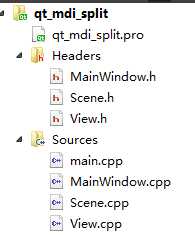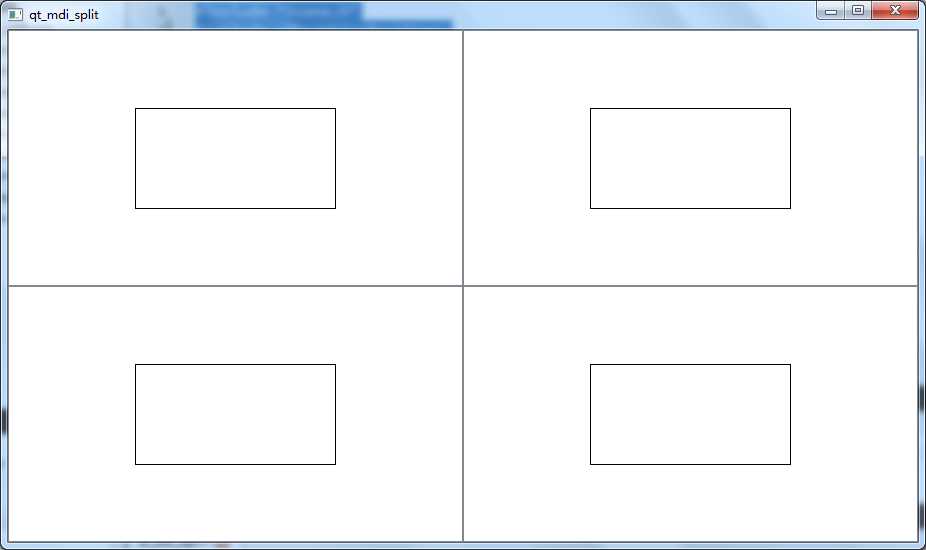vc++如何实现屏幕监控画面自适应?
Posted
tags:
篇首语:本文由小常识网(cha138.com)小编为大家整理,主要介绍了vc++如何实现屏幕监控画面自适应?相关的知识,希望对你有一定的参考价值。
vc++如何实现屏幕监控画面自适应
参考技术A 依据绘制窗口的大小将获得的帧数据进行缩放绘制即可。StretchDIBits(hMemDC,
0, 0,clientRect.right, clientRect.bottom, //绘制区域的大小,clientRect用GetClientRect等获得
0, 0, mat.cols, mat.rows,//实际帧数据的大小,此处用的opencv保存的数据
mat.data,//帧数据内容,此处用的opencv保存的数据
m_bitBuffer, //bitmap结构BITMAPINFO的指针,依据帧数据实际大小和配色进行赋值即可。
DIB_RGB_COLORS, SRCCOPY);
Qt多文档实现屏幕空间(类似监控多画面)效果
Qt多文档程序中的每一个子窗口就是一个个的画面,子窗口可以自由拖动,激活来使用。
现实中,类似于监控的多画面同时排列显示比较常见,也比较实用。
实现思路:
1、响应窗口的resizeEvent事件
2、根据分割数目,通过setGeometry动态设置子窗口相对位置
代码如下:
1 #ifndef MAINWINDOW_H 2 #define MAINWINDOW_H 3 4 #include <QMainWindow> 5 6 class QMdiArea; 7 class QMdiSubWindow; 8 class MainWindow : public QMainWindow 9 { 10 Q_OBJECT 11 12 public: 13 MainWindow(QWidget *parent = nullptr); 14 ~MainWindow(); 15 16 protected: 17 virtual void resizeEvent(QResizeEvent *event); 18 19 private: 20 void splitWindow(QList<QMdiSubWindow *> list, QSize windowSize); 21 22 private: 23 QMdiArea *m_area; 24 }; 25 26 #endif // MAINWINDOW_H 27 28 29 #include "MainWindow.h" 30 #include <QMdiArea> 31 #include <QMdiSubWindow> 32 #include <QResizeEvent> 33 #include "View.h" 34 #include "Scene.h" 35 36 MainWindow::MainWindow(QWidget *parent) 37 : QMainWindow(parent) 38 , m_area(new QMdiArea()) 39 { 40 /// set mdi area 41 setCentralWidget(m_area); 42 43 /// test... 44 for (int i = 0; i < 4; ++i) { 45 View *view = new View(this); 46 Scene *scene = new Scene(); 47 view->setScene(scene); 48 QMdiSubWindow *subWindow = new QMdiSubWindow(); 49 subWindow->setWidget(view); 50 subWindow->setWindowFlags(Qt::FramelessWindowHint); 51 m_area->addSubWindow(subWindow); 52 } 53 } 54 55 MainWindow::~MainWindow() 56 { 57 58 } 59 60 void MainWindow::resizeEvent(QResizeEvent *event) 61 { 62 if (nullptr != m_area){ 63 QList<QMdiSubWindow *> list = m_area->subWindowList(); 64 QSize windowSize = event->size(); 65 splitWindow(list, windowSize); 66 } 67 68 } 69 70 void MainWindow::splitWindow(QList<QMdiSubWindow *> list, QSize windowSize) 71 { 72 int subWindow = list.size(); 73 switch (subWindow) { 74 case 1: 75 list.at(0)->setGeometry(0, 0, windowSize.width(), windowSize.height()); 76 break; 77 case 2: 78 for (int i = 0; i < subWindow; ++i) { 79 if (i == 0){ 80 list.at(i)->setGeometry(0, 0, windowSize.width() / 2, windowSize.height()); 81 } 82 else { 83 list.at(i)->setGeometry(windowSize.width() / 2, 0, windowSize.width() / 2, windowSize.height()); 84 } 85 } 86 break; 87 case 3: 88 case 4: 89 for (int i = 0; i < subWindow; ++i) { 90 switch (i){ 91 case 0: 92 list.at(i)->setGeometry(0, 0, windowSize.width() / 2, windowSize.height() / 2); 93 break; 94 case 1: 95 list.at(i)->setGeometry(windowSize.width() / 2, 0, windowSize.width() / 2, windowSize.height() / 2); 96 break; 97 case 2: 98 list.at(i)->setGeometry(0, windowSize.height() / 2, windowSize.width() / 2, windowSize.height() / 2); 99 break; 100 case 3: 101 list.at(i)->setGeometry( windowSize.width() / 2, windowSize.height() / 2, windowSize.width() / 2, windowSize.height() / 2); 102 break; 103 } 104 } 105 106 } 107 }
1 #ifndef VIEW_H 2 #define VIEW_H 3 4 #include <QGraphicsView> 5 6 class View : public QGraphicsView 7 { 8 public: 9 View(QWidget *parent = nullptr); 10 }; 11 12 #endif // VIEW_H 13 14 #include "View.h" 15 16 17 View::View(QWidget *parent) 18 : QGraphicsView(parent) 19 { 20 21 }
#ifndef SCENE_H #define SCENE_H #include <QGraphicsScene> class Scene : public QGraphicsScene { public: Scene(); }; #endif // SCENE_H #include "Scene.h" #include <QGraphicsRectItem> Scene::Scene() { QGraphicsRectItem *item = new QGraphicsRectItem(); item->setPos(100, 100); item->setRect(0, 0, 200, 100); item->setFlags(QGraphicsItem::ItemIsMovable); addItem(item); }
构建运行:
以上是关于vc++如何实现屏幕监控画面自适应?的主要内容,如果未能解决你的问题,请参考以下文章